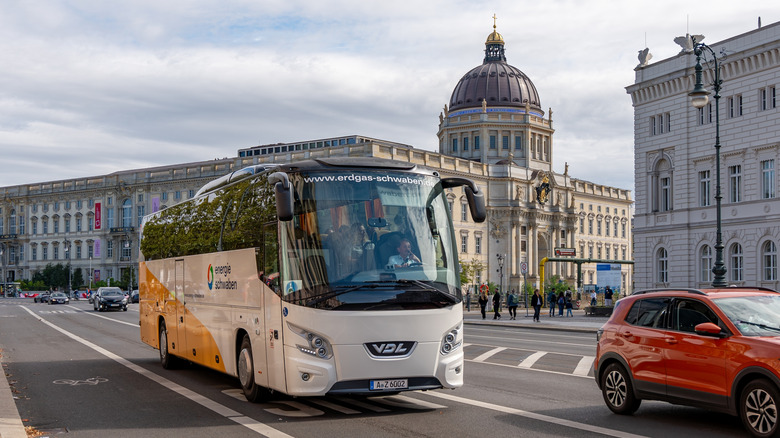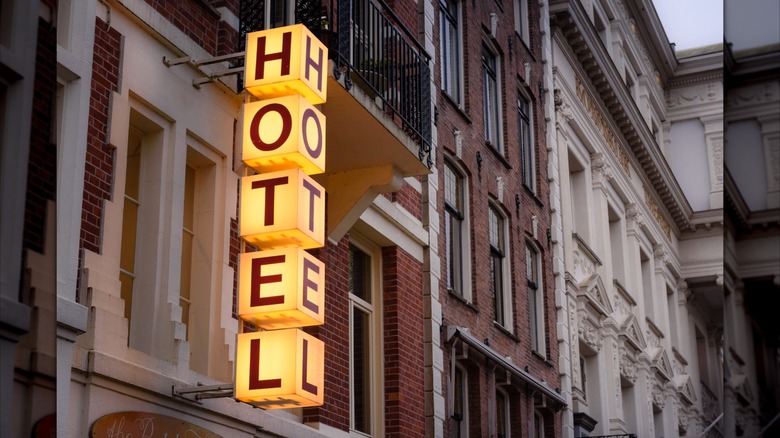Rick Steves' Best Tips For Choosing The Right European Bus Tour And How To Make The Most Of It
With so much to see in Europe, bus tours are often the best option. European destinations are close enough to drive between, but handling all the logistics yourself can detract from the experience. On bus tours, transportation, accommodations, and sightseeing are bundled together, so you can sit back and enjoy the ride — literally. However, not all bus tours are created equal. Some rush through bucket list attractions, while others provide meaningful encounters and adequate free time. So, how do you tell the good from the bad?
To discover how to choose the best European bus tour, we turned to Rick Steves, a renowned authority on European travel. He's explored all corners of the continent, from popular cities to quaint villages and stunning remote landscapes. Aside from personal travels, his expertise in bus tours comes from running his own tour company. He takes over 30,000 people to Europe annually and several of Steves' 10 best-selling European tours include bus options. But regardless of whether you choose Rick Steves Travel or another provider, he encourages thorough research and considering the following tips before booking your adventure.
Stick to smaller groups
We've all seen those massive groups rolling into tourist sites. The kind where people come off buses in droves and are shuttled around like cattle. Not only are these large tour groups wildly impersonal but traveling with so many people can be limiting. Part of Europe's charm is its quaint alleyways and cozy establishments. But as Rick Steves explains, a group of 50 tourists can't access these small spaces, which is why he recommends traveling in smaller groups.
What constitutes smaller groups? Steves considers 24 to 28 travelers a small-group bus tour. This is the amount he takes on his tours — and for good reason. That cute pub famous for its pints? A small group can squeeze in, but a large mob is out of the question. And that charming hotel in the town square? You'd be hard-pressed to find availability for larger groups. Plus, within a city, tours often use public transport to get around. Traveling with a group of 50 on subways and buses will feel like herding cats.
In larger groups, you may end up feeling like a number. On his YouTube channel, Rick Steves Europe, tour guide Cecilia Battai shares that "You cannot take care of 50 people if you really want to meet the needs of all tour members." After all, it's nearly impossible to remember 50 different names — or even faces. You may end up competing to hear your tour guide or ask questions on outings. With a more intimate group, you're more likely to have a voice and build camaraderie with fellow travelers.
Opt for centrally located hotels
When a tour company says you're staying overnight in Paris, don't expect a hotel in the city center. "Paris" could merely mean you're within the city limits, but far from any notable sites. While booking hotels on the outskirts of town saves the company money, it puts a damper on your experience. On his YouTube channel, Rick Steves explains "Big, international hotels outside the historic center, while very comfortable, build a wall between you and the people and culture you traveled so far to experience." This is why Steves encourages you to ask exactly where your accommodations are located and choose tours with centrally located hotels.
Centrally located accommodations help you enjoy your free time and connect with the local vibe because when you're not being transported around by bus, you'll want to stretch those legs. What better way to do that than a walk around those quintessential European streets? Munich is considered the most walkable city in the world, while Milan is considered the second most pedestrian-friendly city globally with plenty of shopping and cafes.
Avoid one-nighters in destinations
Rick Steves also recommends avoiding one-night stands — with hotels, that is. You see, many tour companies only stay at destinations for one night. They rush through sightseeing with the mentality that the more places you visit, the better. However, this type of travel merely skims the surface of a place. You don't get a proper feel for the location. It's more about ticking off boxes and you end up exhausted by so much running around.
If you've perused Steves bus tours, you'll notice they almost all involve staying at each accommodation for two nights or longer. This allows you to settle in more comfortably and get a proper night's rest. You don't need to worry about packing and unpacking every single day. It also enables you to soak in the local atmosphere more deeply. Instead of solely visiting the top few sites, you have time for more authentic cultural experiences, which is exactly what we recommend when planning your first trip to Europe.
Check the dining options
What you eat while traveling highly impacts your overall experience, so do your due diligence and ask the right questions in advance. What meals are included in your tour? Will your guides take you to authentic local eateries or stop at enormous roadside buffets?
Rick Steves notes that many travelers lumped into thoughtlessly curated bus tours can find the food not only subpar, but inauthentic. Think large, impersonal restaurants or hotel buffets that offer cheap, generic meals. You also don't want the cheesy, manufactured tourist traps; you want the real deal. As such, he encourages travelers to not only find a tour that looks to highlight local restaurants but also famed regional delicacies. After all, that century-old Italian trattoria or a beloved Parisian bakery creates far more memorable experiences.
Steves also suggests opting for tours that don't cover every single meal. This flexibility allows you to explore on your own, discovering hidden gems or visiting that fancy restaurant you've been dreaming about. In a video for Rick Steves' Europe, he encourages travelers to "leave the tourist zones. Find restaurants filled with locals enjoying seasonal and regional specialties." Luckily, these self-sponsored meals provide the perfect opportunity to do so!
Pay attention to what's included in the tour price
If a tour's price feels too good to be true, it probably is. Oftentimes, tours offer dirt-cheap pricing but only cover hotels and transport. To make up the difference, Rick Steves explains that budget tours will offer "optional" sightseeing that you can tack on to the trip. Unfortunately, these excursions often come at a price, charging you $50 or $100 extra. This all adds up to something less budget friendly than you thought. So, chances are, if you've made it all the way to Rome for a song, you're going to pay extra to see the Colosseum.
Before choosing a European bus tour, check what's included in the price. Consider meals, accommodations, transport to and within each destination, and sightseeing. Those who prefer a preset itinerary should see what's covered, and if excursions and meals are extra, do the math. Paying for an all-inclusive bus tour may work out cheaper. However, if hotel and bus fares are all you require, those cheap deals may pay off. This is particularly true for budget travelers who prefer to create their own itineraries. In this situation, consider traveling through Europe with affordable long-distance bus companies and booking accommodation separately.
Finally, consider quality. Ask what type of hotels and restaurants you'll be visiting. When looking for luxury, that higher price tag might be worth it. When aiming for an economic experience, you can forego the extra perks. And if hoping to save money on that upcoming trip, check out Steves' budget-friendly ways to enjoy European cities.





